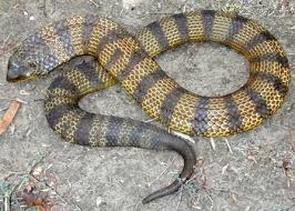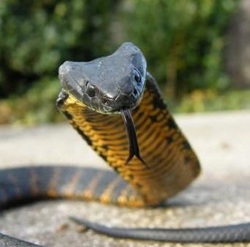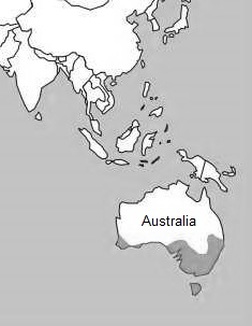Tiger SnakeNotechis scutatus |

Custom Search
|
|
The tiger snake (Notechis) is a large and highly venomous snake species found in Australia. Their range is non-continuous and located within 2 main regions, southeastern Australia, including the Bass Strait islands and Tasmania, and the southwestern part of Australia.
All tiger snakes belong to the genus Notechis in the family Elapidae, but the widely dispersed populations and their diverse characteristics have lead to them being described as distinct species and or into several subspecies. They show a high variance in their size color and pattern, although they often display a banded pattern like a tiger, hence their common name, patternless individuals are also common. Their upper body color varies from gray, olive, yellow, orange-brown to almost black. While the underside is a light yellow or orange. In juvenile snakes, banding is often much more distinct but gradually fades as the snake matures. These are relatively short and stout bodied snakes with a broad head, most individuals reach around 3.9 to 5.2 ft (1.2 to 1.6m) in length. But the particularly large population found in Chapel island averages over 6 ft (1.9m) and may reach 9.5ft (2.9m).

The tiger snake is more active during the warmer months, in cooler weather, they aestivate in animal burrows as deep as 1.2m, under large boulders or dead trees. But they may also be found basking outside on warmer winter days.
Tiger snakes known predators include the small-eyed snake (Cryptophis nigrescens) and birds of prey such as harriers, goshawks, butcherbirds, ibises, kookaburras and kites. Taxonomy / Subspecies The tiger snake taxonomy is a matter of intense debate, ranging from several sub-species to the most commonly accepted 2 species, the mainland tiger snake (Notechis scutatus) and the black tiger snake (Notechis ater). Some authorities even consider it as just 1 species, although highly variable in both size and appearance, describing Notechis as a monotypic genus. A revision of the genus is under consideration. These are the most widely accepted subspecies: Mainland tiger snake (Notechis scutatus) - Found in New South Wales, Queensland, South Australia, Victoria and Western Australia. Black tiger snake (Notechis ater) - Found in Western Australia, South Australia, and Tasmania. The other subspecies sometimes considered in literature: Eastern Tiger Snake (Notechis scutatus scutatus) - Found in the southeastern region of mainland Australia. Western Tiger Snake (Notechis scutatus occidentalis) - Found in the southwest part of Western Australia. Krefft’s Tiger Snake (Notechis ater ater) - Found in Flinders Ranges in South Australia. Tasmanian Tiger Snake (Notechis ater humphreysi) - Found in King and Tasmania islands. Peninsular Tiger Snake (Notechis ater niger) - Found in the Yorke and lower Eyre Peninsulas and offshore islands of South Australia. Chappell Island Tiger Snake (Notechis ater serventyi) - Found in Chappell Island in Furneaux Group located in the Bass Strait. Venom / Bite The tiger snake venom is very potent, strongly neurotoxic and coagulant, it's composed of a cocktail of neurotoxins, coagulants, myotoxins and hemolysins. The main symptoms following a bite include localized pain, numbness, tingling, and sweating, rapidly followed by breathing difficulties and paralysis. One study reported that if left untreated the tiger snake bite mortality rate was between 40 and 60%, anyone suspected of being bitten by one should seek medical help immediately. These snakes are commonly considered some of the most dangerous in Australia. In the past, the tiger snake was the species that caused more snake bite fatalities in Australia, but in nowadays the eastern brown snake has taken over the first place. The incidence of fatal tiger snake bites was substantially reduced with increased availability of antivenom. Diet / Feeding The tiger snake main diet is composed of frogs and tadpoles. Even though they love eating frogs if the opportunity arises, they will also kill and eat small mammals, bats, lizards, skinks, insects, birds, fish and also carrion. Tiger snakes also practice cannibalism. They will hunt for prey mostly in the daytime but in very hot weather they often feed during evening or night time. The prey is grabbed and quickly subdued with the injection of their powerful venom, on occasion, they also constrict the victim as well. The average prey size increases with the size of the snake. The average prey size probably plays a major role in the species adult size. On one hand, the Chappell Island population is composed of very large snakes, because of the abundance of fat muttonbird chicks, on the other hand in the Roxby Island, the population of smaller almost dwarf snakes feeds mostly on small skinks. Reproduction The mating season takes place in spring when males engage in ritualistic combats, lasting as long as seven hours. In these combats they try to press down each other's head, and sometimes end up intertwined. Tiger snakes are ovoviviparous, females give birth to live young between late summer and mid-autumn. The clutch size ranges from 10 to 64 younglings, which are born inside a membranous sac, but once they break free they are totally independent. Conservation / Threats Chappell Island and Flinders Ranges populations are listed as vulnerable by the Commonwealth and IUCN. The population of Flinders Range is declining and threatened by soil erosion, overgrazing, water pollution and competition for food by the introduced trout. The tiger snake, like most snakes, is heavily persecuted by humans and is routinely killed on sight, some specimens also become road victims. They are protected species in most Australian states and it's also illegal to export any native Australian snake.
|
Did You Know?
The Mojave rattlesnake venom is regarded as the most toxic of any rattlesnake because of the presence of the "Mojave toxin". Scientific classification |
© 2014 Snake Facts About Us | Privacy Policy | Contact




